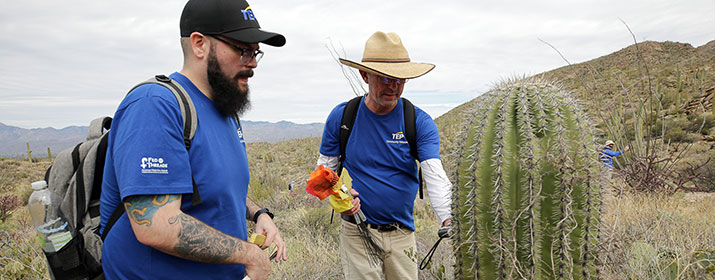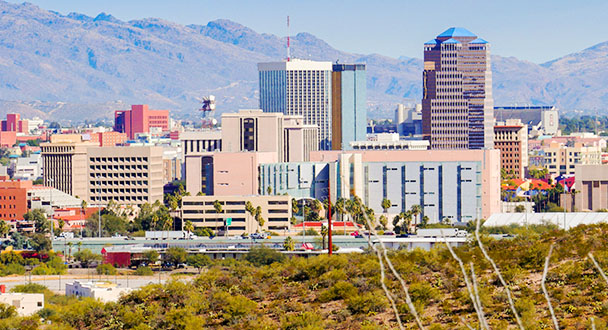
The employees who work for the Land Resources Department at Tucson Electric Power typically spend their days poring over maps, charts, plats and permits.
But one spring morning, two dozen team members instead found themselves peering into clusters of cholla and peeping under mesquite trees in Saguaro National Park, searching for saguaros of all sizes. It takes focus. Even at 10 years of age, the cacti are still less than three inches tall.
The team was participating in the 2020 Saguaro Census count, a massive undertaking that happens each decade at the park.
“It’s how we keep track of the health of our saguaros,” said Don Swann, a wildlife biologist for the National Park Service. “They live a long time – longer than we do – and this count helps us understand how the population is doing.”
Young saguaros are particularly vulnerable because they are not big enough to store water that can sustain them in the high desert temperatures. An extended drought, as our region has experienced, can have significant impacts on the population.
The count relies heavily on volunteers and interns to comb plots of desert.
Shannon Breslin, Manager of Land Resources, served for six years as a board member for the Friends of Saguaro National Park – one of a long string of TEP employees to serve in that role.
She had been looking for a way to bring her whole team together, despite their varied responsibilities in environmental planning, transmission patrol, vegetation management and land rights. “We have different roles, but ultimately, everything we do touches the Sonoran desert,” said Breslin, who only recently cycled off the board so fellow TEP employee, Kai Pan, could serve. “It was a unique opportunity to go out there and do some team building that was an extension of our work here, while also giving back to the community and supporting the biologists who manage this incredible resource.”
Right-of-Way Agent Elizabeth Boehler is the first to tell you she’s not the outdoorsy type. Fair-skinned, she didn’t relish the idea of making her way through the desert under the sun for a day.
And she would do it again in a heartbeat. “We had a chance to see photos of what the saguaro stands looked like half a century ago and it was obvious that there has been a significant decline. It really spoke to our hearts, because this is our home, and it’s important to do our part. I felt like I was contributing in some way.”
Brian Pugh, a TEP Environmental Planner, also enjoyed the experience. “The part that impressed everyone is that the work we did will be used by scientists decades from now. It gave us all a lot of enthusiasm to know we were part of something that would go on through time.”
Exploring the saguaro forests was further inspiration for the work he does, he said, which is to preserve natural resources while working to improve the resiliency of the electrical grid.
Swann said he appreciates TEP’s longstanding relationship with the park and its fundraising arm. “The census is a big community effort and we are thrilled to have corporate support. The TEP team was super engaged about the work and about their service to the community.”
And there was even a bit of good news. While the count had to be put on hold because of the response to the coronavirus pandemic, some preliminary findings were promising: Despite 20 years of very little new growth in response to the drought, some newly established saguaros were found in some parts of the park.
The count is expected to resume in the fall.






